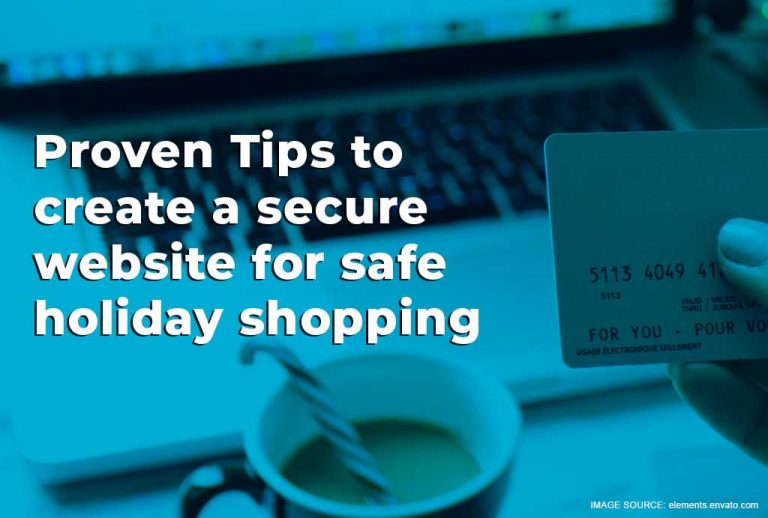Though today’s focus is on making holiday shopping more secure, protecting website visitors should be one of your top priorities, all the time. There are a few things you can do, some are free while others aren’t; some are one time jobs while others aren’t. Either way, you will find options to meet your individual needs as you seek to create a website for your customers to feel safe enough to shop with you.
Table of Contents
Holiday Shopping
Cyber Monday is said to be where the online holiday shopping season officially begins. However, in 2019, the five days between Thanksgiving and Cyber Monday saw e-commerce vendors profiting from $28.5b in sales. In fact, Cyber Monday alone was responsible for just under $9.5b worth of goods. This digital shopping spree tends to go on until just before Christmas when people tend to want to spread Christmas cheer in person.
To ensure you benefit from some of this profit, and build trust in your customers, it is not enough to simply create a website. You need to create a secure website that delivers the best digital shopping experience. Here are eight ways that you can help bring about this.
8 Tips to Secure your E-Commerce Website
Use SSL Certificates for encryption
When you create a website using our website builder, there is a wide variety of features and applications from which to choose. Among your selection should be SSL certificates.
SSL certificates are the most tangible means of showing your customers that their information is secure.
This is so because of the prominent lock symbol displayed in the URL address bar, and the transfer from ‘http’ to ‘https’.
Don’t Store Customers’ Payment Information
Storing customer details means that you are creating a central location for hackers to target. While some amount of information storage is needed, try to store the bare minimum needed to complete transactions. Furthermore, consider using third-party payment options that will handle information collection for you. Finally, do not include storage of payment information as default when you create your website.
If you wish to be able to store this information, aim to receive Payment Card Industry Data Security Standard certification. Then proudly display the PCI DSS badge to provide another level of peace of mind for your customers.
Change Default Information
Where appropriate, change default information. When you create a website, there may be settings and passwords that need to be provided by your web host. These are usually generic, simple, and meant to be temporary. Hackers are familiar with these passwords or may try variations, and use them to attempt entry into your backend. Should a hacker gain control of your website’s backend, they are able to do almost anything with your website.
Another way your website can be stolen from you is if your domain is not locked. Locked domains provide you, the domain owner, with some guarantee that your website usually cannot be stolen, and used to benefit others unlawfully. When you create a website, your domain is locked temporarily, but you should ensure this lock remains in place until you need to make changes.
Try to Incorporate Geolocation Technology
Have you ever left the country without informing your bank? What happened when you tried to access online banking, or use your credit card? Geolocation technology made it possible for your bank to detect that access or usage from outside the country. Since there is no report of your having left the country, this action could signal an attempted fraud.
You too can use similar practices to safeguard yourself from this kind of fraudulence. This impacts you because you may be denied payment by the bank, and will certainly incur a penalty if you are PCI DSS certified. Geolocation can help limit these instances, as well as reduce the stress and waste of resources involved with these kinds of activities.
Enforce Password Best Practices
Passwords remain to be a very topical issue as alarming numbers continue to ignore their value. The onus is on your customers to create secure passwords. However, they do not always do so. It helps to assist them in this effort. You can do this by including clues to the strength of chosen passwords, or establishing parameters for passwords to be used on your website. This would include reminding them not to recycle passwords, to create passwords of a certain length, and so forth.
Keep your Software and Equipment Updated
The latest version of every software, plugin, theme and other application relevant to the functioning of your e-commerce website must be up to date. Included in this is your computer’s operating system. Updates usually come with fixes for previously identified vulnerabilities, as well as any foreseen challenge.
Be Mindful How you Use Your Equipment
Who is using the computer system and network your website relies on? What are they doing, downloading, and opening on it? Are other employees using strong passwords for their administrative functions? Do you have detection software looking out for viruses, failed hacks, and other types of attacks? Poor security hygiene can leave your system open to malware, ransomware and other attacks.
Backup! Backup! Backup!
When you create a website, the farthest thing from your mind is being hacked. But the possibility is very real. Therefore, perform regular backups, and use cloud-based backup. Cloud-based backup provides the best chances of restoring your information with the shortest possible downtime. However, keep in mind that it is better to prevent a breach than to have to explain to your customers, and lose their trust and your reputation.
Conclusion
Website security is important. Website security is ultimately your responsibility. Website security is an ongoing process. Website security provides both you and your visitors with peace of mind. Website security is worth it, not just during holidays, but all the time.






